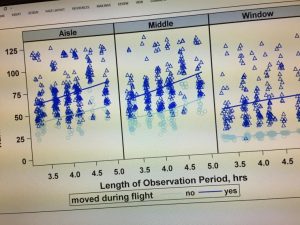 An airline passenger with influenza or other respiratory infection will not transmit infection to passengers seated more than two seats away laterally or one row in front or back, US research suggests.
An airline passenger with influenza or other respiratory infection will not transmit infection to passengers seated more than two seats away laterally or one row in front or back, US research suggests.
The findings come from in-flight infection tracking study carried out by airborne researchers from the Georgia Institute of Technology
To model the likely transmission patterns of in-flight respiratory infections, researchers made five East-West round trips in the US recording movements of passengers and crew.
They collected air samples and obtained surface samples from specific areas of the passenger cabin most likely to harbour infectious ‘fomites’.
Publishing their modelling in Proceedings of the National Academy of Sciences, the researchers concluded that direct transmission of respiratory tract infections was unlikely to fellow passengers more than one metre away.
“This is more conservative than current public health guidance, calling for surveillance of passengers within two rows of an infectious passenger,” they noted.